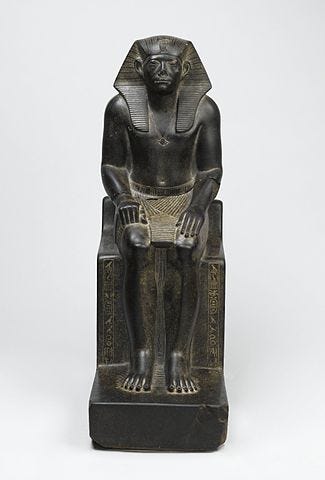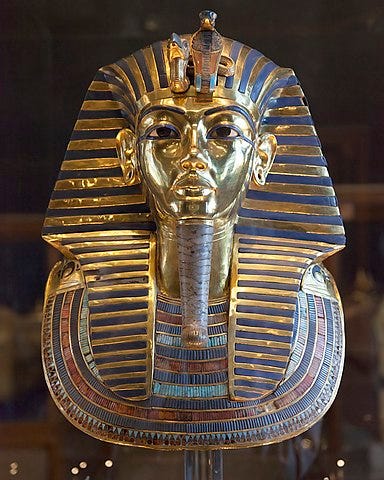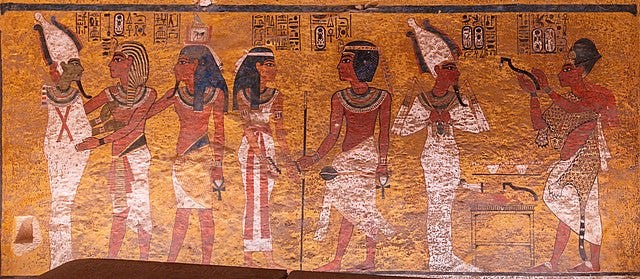Old, but not outdated
Course in Humanities: Fortnight #8
Today I’m sharing my thoughts on the eighth fortnight of our adapted version of Ted Gioia’s Course in Humanities.
You can find previous parts of this course at the end of this post.
For now, we’ll discuss:
a) Ancient Egyptian architecture and art.
b) The Nonesuch Explorer album of oud music from Southern Egypt; Desert blues (Ali Farka Touré, Tinariwen); Youssou N'Dour’s Egypt album.
c) Ancient Egyptian hymns, prayers and songs (Susan Tower Hollis collection).
Ancient Egyptian architecture and art
Ancient Egypt was already a major civilization during a time when the rest of of the world was “learning to walk”. For two thousand years (3100 - 1100 BCE), after which it entered a decline stage it never overcame, Egypt was a beacon of development and sophistication that inspired a lot of its neighbors, especially the Greeks.
Unlike other ancient or Mediterranean cultures, Egyptian art and architecture remained fairly stable. You could say they mastered what they liked and stuck with it.
Egyptian art evolved slowly (the oldest pottery and sculptures we found date back to 5000 BCE). By the time the First Dynasty established itself (c. 2972 - 2793 BCE), many of the basic motifs and forms we associate with Egypt can already been seen.
Their style was grandiose, opulent, monumental, shining or colorful, and highly practical, being directly linked to religious and funerary practices.
There seems to have been a “correct” form of depiction for statues, sculptures, carvings, paintings and writing that served ritualistic purposes. There was no perspective and the focus was entirely on the person, deity or story portrayed, not the craftsmen.
Egyptian history is typically divided (or highlighted) in three periods1: Old Kingdom (c. 2647 - 2124 BCE), Middle Kingdom (c. 2040 - 1648 BCE) and New Kingdom (c. 1540 - 1069 BCE).
The most prominent example of art and architecture from the Old Kingdom are the Great Sphinx2 and Pyramids of Giza:

During the Middle Kingdom, cultural and religious changes occurred (the status of the king, proceedings regarding the afterlife, rites, societal organization and foreign policy), which led to changes in art, architecture and literature.
However, many remains from that period are poorly preserved. Luckly, there are some left:

When it comes to the New Kingdom, the most famous pharaohs, and their corresponding artifacts, are probably Tutankhamun and Rameses II.
We sure looted Tutankhamun’s tomb:


Yet, despite the fact they’re long gone, the ancient Egyptians keep fascinating us with some of the most impressive art and architecture ever made by Homo sapiens.3
Music
I struggled with the songs Gioia recommended this time.
They’re so different from what I’m used to and finding reliable translations of the lyrics isn’t a piece of cake.
Still I did enjoy the Nonesuch Explorer album from Southern Egypt (these Nonesuch people really know how to make albums or, at the very least, hire people who do) and an assorted playlist of Tinariwen (I liked the rhythms and voices).
I didn’t care much for Ali Farka Touré and couldn’t connect at all to Youssou N'Dour’s Egypt album.
Ancient Egyptian hymns, prayers and songs
The edition Gioia recommended was not easy to find, but fortunately ancient Egypt has been fascinating the world for a while, which means there are plenty of collections to pick from in case you’re not able to find a copy of Hollis’.
On the poems themselves, the majority are religious, but there a few secular lyrics in the mix. They can be found in tombs, steles and papyri. The Hollis collection offers a good sample of what is out there, including a selection from the Book of the Dead, covering different periods and themes/objects of adoration.
The Egyptians believed in many gods, though their beliefs seemed to have converged to a main, creator god, above all else, as the centuries went by.
Their hymns, prayers and songs were a way to worship or converse with said deities, among which was included the Pharaoh, considered to be/manifest Horus, and his late father, in the figure of Osiris.
They had faith in the afterlife, which was to be happy in the company of the gods. That’s one of the reasons their temples and tombs (houses of eternity) were made to last much longer than regular, everyday constructions, meant for the temporary life above the earth. It was eternal life, not death itself, that captured their attention and a lot of their efforts.
The poems in the Hollis collection are over three millennia old, some of them are around forty-five hundred years old. They were most likely written by men from priestly and aristocratic backgrounds.
Ancient Egyptian poetry usually presents itself in three forms: narrative (stories and myths), didactic (instructional or hortatory) and lyric (hymns, prayers and songs).
They tend to be written in couplets (triplets and quatrains sometimes appear). Parallelism is also common, both in terms of structure (repetitions, grammar, clause construction) and content (vocabulary, ideas)4.
For me, the most interesting part about reading the religious texts was watching power and cultural structures at play. Faith and rite had a massive impact in their way of life.
However, that does not mean every second of everyday in their lives was about religion.
We must remember only a fraction of what they wrote was preserved and tombs (and papyri copies of what was written on their walls), made to stand the test of time, automatically carry religious symbolism.
In fact, the Harper’s songs, which focus on enjoying “earthly” living, and the love poems, secular in nature, are more relatable than anything else in Hollis collection.
They remind me of Horace and 16th and 17th century English poetry carpe diem or love songs by troubadours.
While culture can change our behavior way faster than our genes, it hasn’t succeeded in changing that much.
We’re still the same, we just have more gadgets now.
This is it for today.
I hope you’ll join me for next fortnight.
In case you haven’t read them, here are parts One, Two, Three, Four, Five, Six and Seven.
Dates may vary.
The Egyptian sphinx had the body of a lion and a human head.
Can we stop with conspiracy theories about aliens and the pyramids, please?
Still regarding structure and content, a close reading of biblical poetry indicates jews might have been influenced by Egyptian literature as well.


